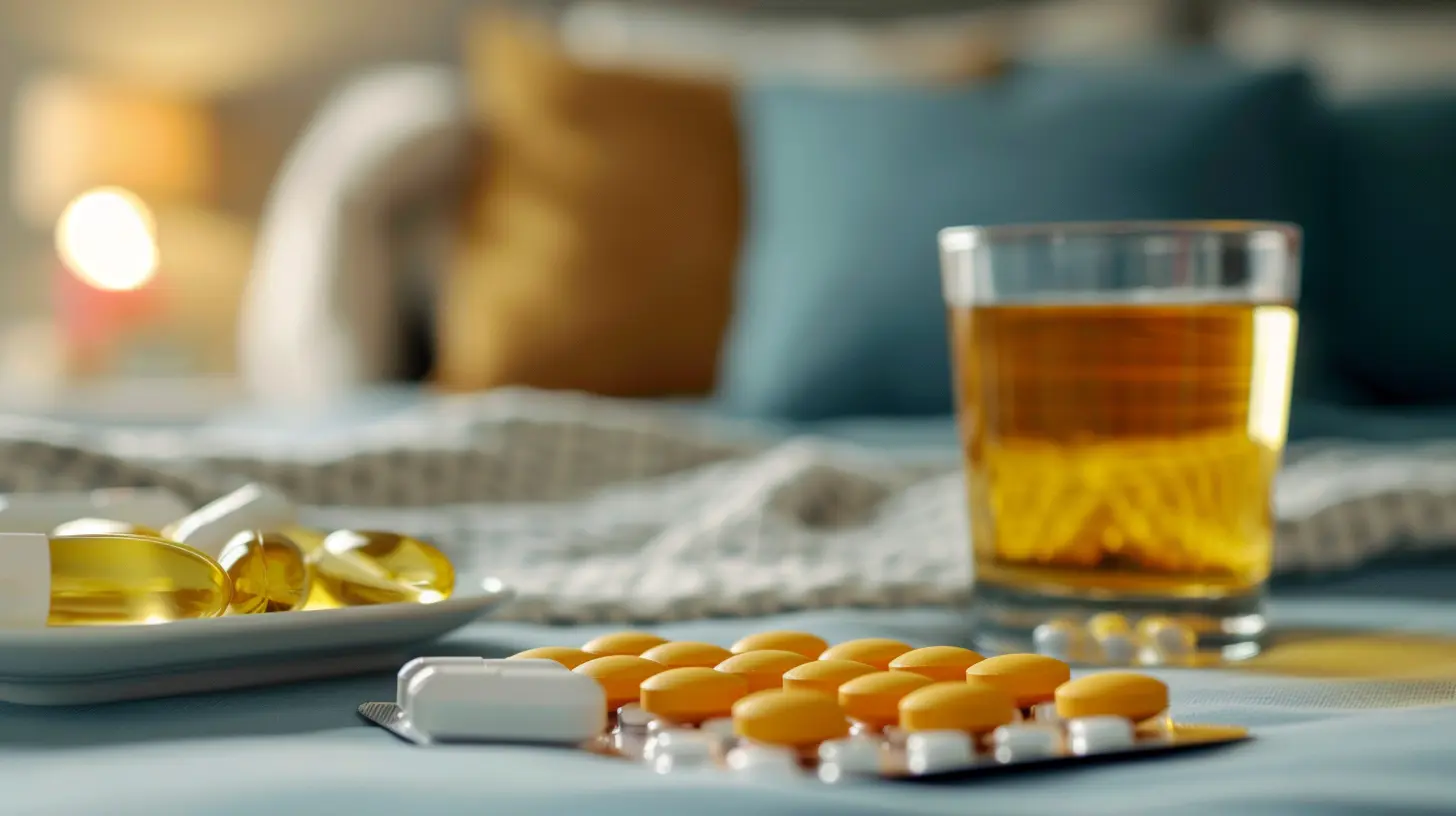How to Handle Sick Days When You Have Diabetes
24 October 2025
Let’s face it — being sick is never fun. But when you have diabetes? It becomes a whole new level of stress. Your blood sugar goes haywire, your appetite disappears, and trying to keep things in check feels like juggling flaming swords blindfolded.
If you’ve ever been curled up in bed with a fever, wondering how to take care of both your illness and your diabetes, you’re not alone. Managing a chronic condition like diabetes becomes trickier when you're dealing with the flu, a stomach bug, or even a stubborn cold. But here's the good news — with a little planning and awareness, you can absolutely handle sick days without letting diabetes knock you down.
In this post, we're going to walk through everything you need to know: from why your blood sugar rises when you're sick, to what you should eat, drink, and monitor. It’s like having a game plan in your back pocket — because the best time to prepare is before you’re hit with the sniffles.
Why Do Sick Days Mess With Your Blood Sugar?
You might be thinking, "Wait, I’m barely eating… why is my blood sugar high?" Great question. Here's what’s happening behind the scenes:When you're sick — even with something mild like a cold — your body sees it as a threat. So, it releases stress hormones like cortisol and adrenaline to help fight off the invaders. The problem? Those same hormones cause your liver to release more glucose into your bloodstream.
So, even if you’re not eating much, your blood sugar can still spike thanks to this internal response. It’s your body trying to help, but for people with diabetes, it can backfire.
Sick Day Rule #1: Keep Checking Your Blood Sugar
It's tempting to skip your usual routine when you're under the weather. But now’s not the time to slack on blood sugar monitoring.Aim to check every 2–4 hours.
Why so often? Because illness can make your levels unpredictable. You want to catch highs (hyperglycemia) and lows (hypoglycemia) before they become dangerous.If you take insulin, your needs might change — and you won’t know unless you’re checking regularly.
Helpful tip: Keep a notebook or use your app to track how your blood sugar reacts during different illnesses. You might start to notice patterns.
Don't Stop Taking Your Medication — Even if You're Not Eating
This one trips a lot of people up. If you're not eating much, it might feel like you should hold off on your diabetes meds too. But stopping your insulin or oral meds without guidance? That can lead to serious issues like diabetic ketoacidosis (DKA), especially if you have type 1 diabetes.Instead, talk to your healthcare provider about a “sick day plan.” They might suggest:
- Adjusting your insulin dose
- Using rapid-acting insulin more often
- Skipping certain oral meds just for that day
But again — don’t wing it. Call your doctor or diabetes educator. Better safe than sorry.
Hydration Is Your Best Friend
On sick days, water is like your secret weapon. Fevers, vomiting, or diarrhea can leave you dehydrated fast — and that alone can spike your blood sugar.Aim for at least 8 ounces of fluid every hour when you're awake, especially if you're losing fluids.
Good hydration options include:
- Water (obviously!)
- Sugar-free electrolyte drinks
- Broth-based soups
- Herbal teas with a bit of honey if your throat’s sore
Avoid sugary sodas or juices unless your blood sugar is low and you need a quick boost.
What If You Can’t Keep Food Down?
Ugh. Nausea and vomiting are the actual worst — but even if you’re not eating solid foods, your body still needs fuel, especially when you’re sick.Try these gentle, carb-containing options to prevent hypoglycemia:
- Sugar-free popsicles
- Clear fruit juices diluted with water (like apple juice)
- Saltine crackers (if you can tolerate solids)
- Plain toast
- Applesauce
- Rice or mashed potatoes
Your goal should be to eat 45–50 grams of carbs every 3–4 hours if possible. Don’t stress if you can’t manage that — just do your best and keep your doc in the loop.
Check for Ketones (Yes, Seriously)
Especially if you have type 1 diabetes, checking your urine for ketones during sick days is super important. High ketones can mean your body is heading toward DKA, a dangerous complication that can land you in the hospital fast.You can buy urine ketone strips at your local pharmacy — quick, easy, and painless.
When should you check for ketones?
- If your blood sugar is over 240 mg/dL
- If you’re vomiting
- If you have flu-like symptoms and feel extra tired or confused
If you find moderate to large amounts of ketones, it’s a red flag. Call your doctor or go to urgent care.
Have a "Sick Day Kit" Ready
Ever try to find a thermometer or test strips when you're burning up and dizzy? Yeah — not fun. Make things easier by preparing a sick day kit before you get hit.Here’s what to include:
- Thermometer
- Extra blood sugar test strips
- Ketone test strips
- Fast-acting carbohydrates (glucose tabs, juice boxes)
- Sugar-free electrolyte drinks (like Gatorade Zero or Pedialyte)
- A list of emergency contacts
- Your provider's "sick day instructions" (print it out!)
Having this kit on hand can save a lot of stress — and might even prevent a trip to the ER.
Know When to Call for Help
Sometimes, you can manage a sick day at home. Other times? Not so much. Don’t wait too long to reach out for support.Here are signs it's time to contact your doctor (or head to the ER):
- You can't keep food or fluids down for more than 6 hours
- Your blood sugar stays above 300 mg/dL even with insulin
- You have trouble breathing or chest pain
- You see moderate or large ketones in your urine
- You feel extremely drowsy, confused, or disoriented
- You show signs of dehydration (dizziness, dry mouth, dark urine)
There's no shame in asking for help. Waiting too long can turn a manageable sick day into a crisis.
Caring for Kids With Diabetes? It’s a Whole Different Ballgame
If you're a parent of a child with diabetes, sick days are even more stressful. You’re juggling medicine, fluids, blood sugar checks, and a cranky kid who just wants to sleep all day.Here are a few extra tips tailored for kiddos:
- Offer fluids every 15–30 minutes — even in small sips
- Use a rewards chart or quiet activities to encourage check-ins
- Be extra vigilant with ketone testing
- Keep their favorite comfort foods handy (bananas, crackers, applesauce)
And stay in touch with your child’s endocrinologist. They’ll guide you on insulin adjustments and when to worry.
The Emotional Side of Sick Days
Let’s not pretend this is only physical. Being sick can mess with your mental health, too — especially when you’re already juggling a chronic condition. You might feel frustrated, anxious, or overwhelmed.And that’s okay. Totally normal.
Here are a few ways to give yourself a little grace:
- Rest as much as you can. This isn’t the time to power through.
- Flip your mindset. Remind yourself that every rough day you survive makes you stronger next time.
- Ask for help. If you live with someone, ask them to bring you fluids, monitor your levels, or help with meals.
- Celebrate small wins. Checked your blood sugar? Ate a saltine? That’s worth a high-five.
You are doing your best — and that’s enough.
Wrapping It All Up: Your Sick Day Survival Strategy
Being sick when you have diabetes doesn’t have to be terrifying. Yes, it adds a few more steps to your care routine — but with the right tools, mindset, and support, you can absolutely weather the storm.Here’s a quick recap of your game plan:
✅ Monitor blood sugar every 2–4 hours
✅ Keep taking your meds (check with your provider if needed)
✅ Stay hydrated like it’s your job
✅ Eat small carb-rich snacks if you can
✅ Check for ketones when needed
✅ Have a sick day kit ready
✅ Know your emergency signs
✅ Give yourself grace and rest
One final thought: You are strong, even on your weakest days. Your body is fighting hard, and so are you. Don’t forget to be kind to yourself when you're under the weather.
We hope this guide makes your next sick day a little less daunting — and a lot more manageable.
all images in this post were generated using AI tools
Category:
DiabetesAuthor:

Madeline Howard
Discussion
rate this article
1 comments
Jolene Ross
Taking care of your health is paramount, especially on sick days. Remember, every moment is an opportunity to nurture your body and mind. Listen to yourself, rest well, and stay positive—your resilience will guide you through!
October 26, 2025 at 3:53 AM

Madeline Howard
Thank you for the reminder! Prioritizing health and self-care is essential, especially for managing diabetes on sick days.


